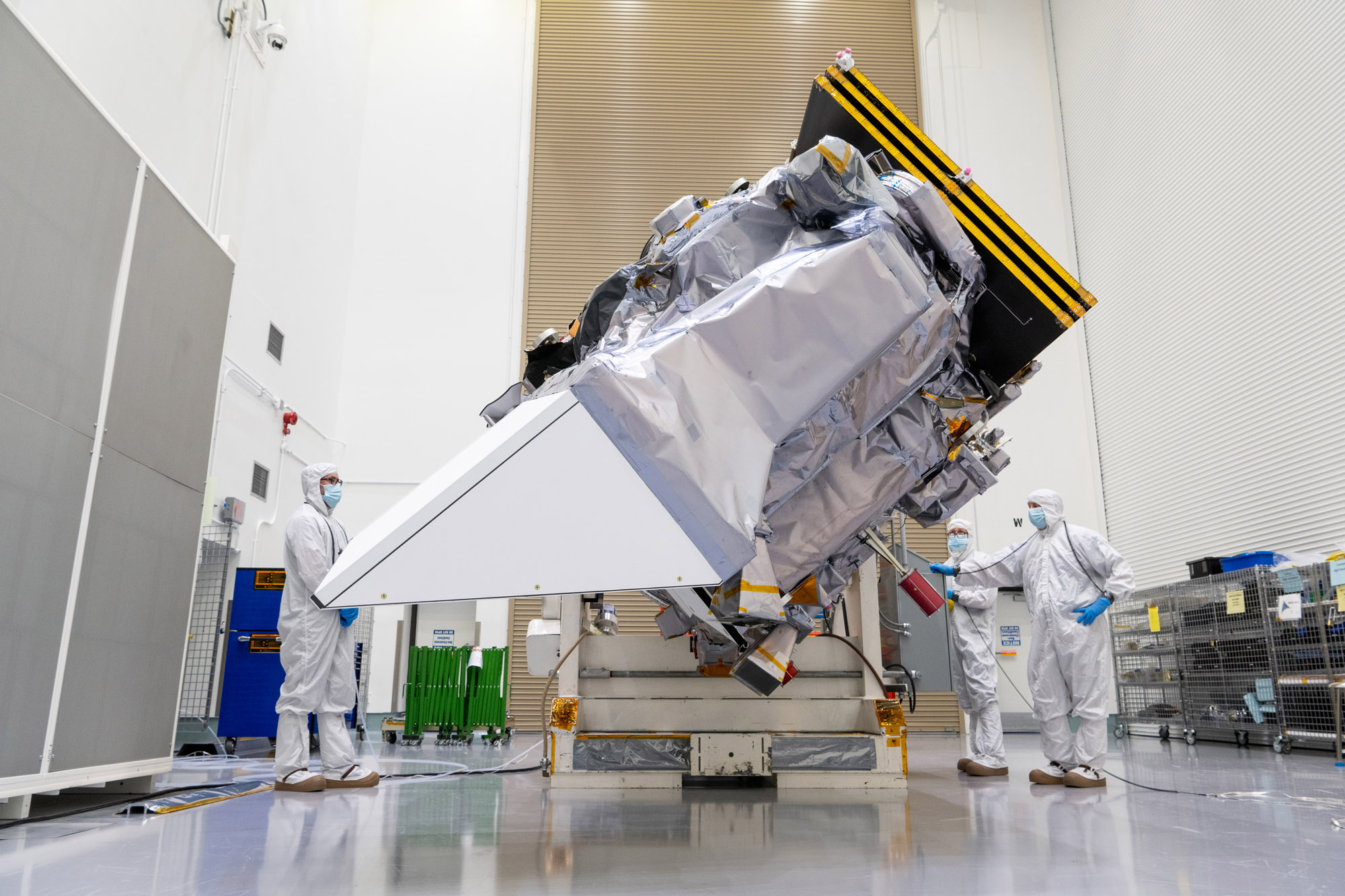
Part of the PACE satellite is observed by a crew at Astrotech Space Operations in Titusville, Florida, on Nov. 16, 2023. (Photo courtesy NASA) A satellite with New Hampshire-made optical components that help detect microscopic ocean plankton and aerosol particles that may inform climate change is in space as of earlier this month.
Engineers at the Corning Advanced Optics plant in Keene used their foundational expertise from earlier work with private space firms and NASA to help build crucial parts of the federal space agency’s PACE satellite, which launched from Cape Canaveral, Florida, on Feb. 8 aboard a SpaceX Falcon 9 rocket after a weather delay.
PACE, an abbreviation of “Plankton, Aerosol, Cloud, Ocean Ecosystem,” is a NASA mission that aims to study how the ocean and Earth’s atmosphere exchange carbon dioxide as well as how aerosols accelerate marine phytoplankton growth. NASA says the satellite mission will have such benefits as identifying how long algal blooms form on bodies of water and how widespread they are, adding to future understanding of climate change models.
The satellite accomplishes this thanks to hyperspectral imaging, a method of sensing technology that searches for substances by way of light that strikes sensors on the satellite, which is where Corning’s knowledge comes in.
Working among 19 other companies involved in the project, staff at Corning’s remote sensing division in Keene helped produce aluminum mirror technology for a telescope-like element of the satellite called the Ocean Color Instrument (OCI), said Bill Pfister, account manager in the remote sensing division.
“There’s a primary first mirror, there’s a reemerging optic, there’s a collimated optic,” Pfister said in a video interview the week after the launch. “These are all front-end optics of a space telescope system where we provided all those mirrors.”
The OCI is a spectrometer, or color sensor tool used for measuring light intensity over various bands of the electromagnetic spectrum. This enables the satellite to observe substances and particles struck by sunlight in seawater like the green pigment chlorophyll, according to NASA. The pigment — found in phytoplankton and land plants — impacts the color of oceans seen by the spectrometer.
PACE is a three-year mission, but the satellite is carrying enough fuel to remain in space and study the planet for up to 10 years, meaning besides longevity, cleanliness of the components before launch was an important factor in a successful mission.
“There were some aspects of the project where NASA chose to just take the unit straight from our coding area, knowing that’s the cleanest they would be, and take them to NASA’s facility in their cleanroom to do some of the final optical evaluations,” Pfister said.
Of the small team of Corning employees on the project, four of them including Pfister were invited to witness the launch in Florida from Kennedy Space Center’s Banana Creek launch viewing area and reconnect with NASA employees who’ve worked with Corning on past missions.
Pfister couldn’t divulge how much Corning’s investment into the PACE mission cost, but company-wide, Corning Incorporated reported $3 billion in fourth-quarter 2023 sales and $12.6 billion in full-year 2023, per data released late last month.
For Corning, the PACE project bears similarities to another partnership the company and Keene plant had with San Francisco firm Orbital Sidekick (OSK) to produce components for a satellite that launched last year intended to detect oil and natural gas leaks. The two projects overlapped, with OSK satellites launching last spring and summer and the PACE work taking place over the past two and a half years.
However, Corning’s contribution with PACE was “a lot smaller than what we did with Orbital Sidekick,” said Leon Desmarais, product line manager of the remote sensing division.
“On this mission, it was more optical design work, then eventually components and subassembly manufacturing, whereas with OSK, we were doing the full camera integration,” Desmarais said in the call with Pfister. “There’s more electronics and systems engineering involved with a payload like OSK versus just providing optical components and design input like we were (with PACE).”
Still, he and Pfister said PACE allowed Corning Advanced Optics staff to further hone their experience in hyperspectral technology.
“(My colleagues) commented that it was great to work with NASA, technical depth and the number of folks in the field that they bring,” Pfister said.